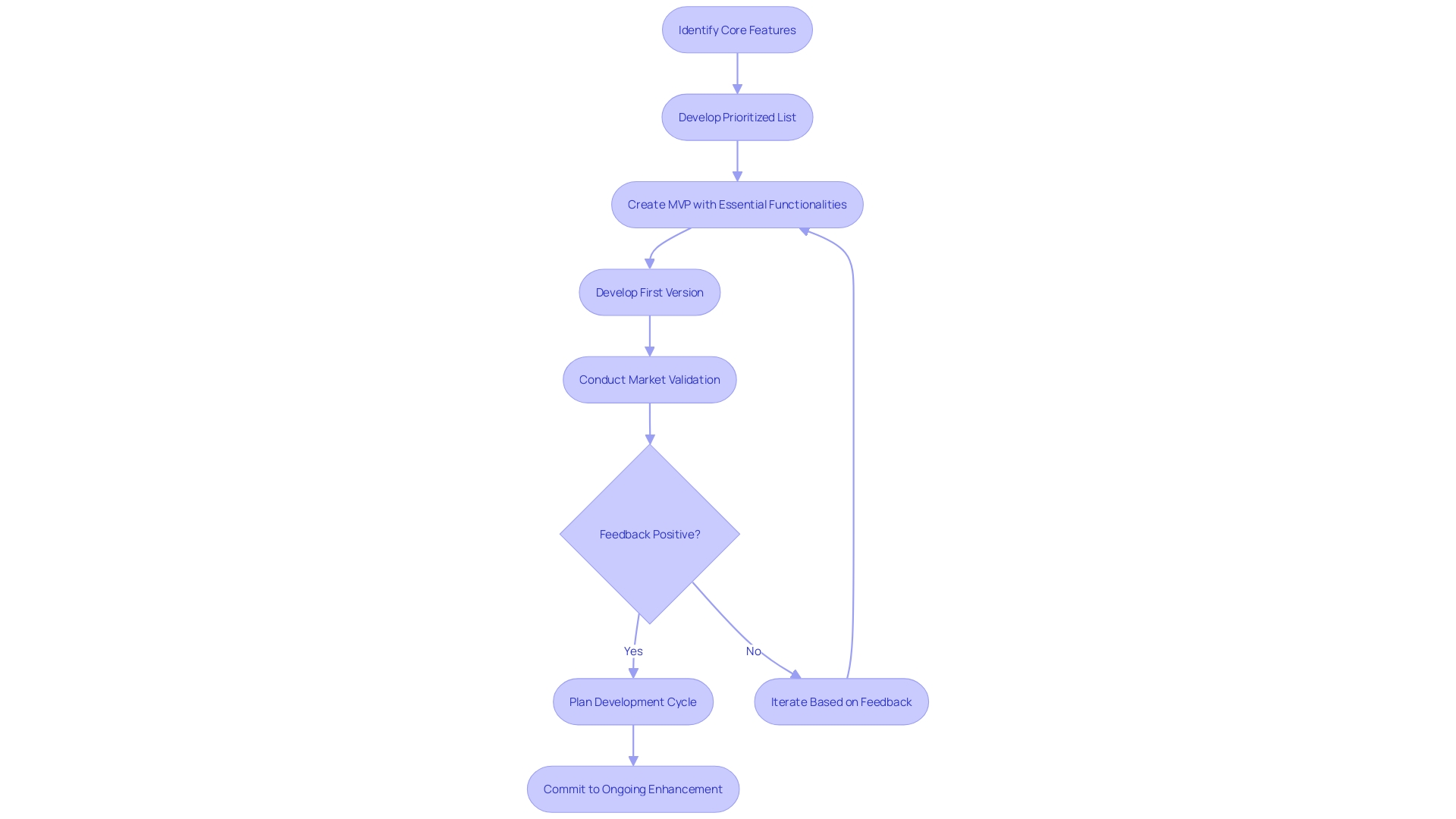Introduction
The concept of a Minimal Viable Product (MVP) is fundamental in the world of software development. It allows companies to quickly deploy a product with essential features, gather valuable feedback, and validate product-market fit early on. In a field where many startups falter, an MVP is crucial for survival and success.
This article explores the benefits of using MVP in software development, the steps to create an MVP, and common pitfalls to avoid. By adopting an MVP approach, businesses can streamline their product, accelerate the feedback loop, and deliver a lean solution that resonates with users. So, let's dive into the world of MVPs and discover how they shape the landscape of software development.
What is an MVP in Software Design?
The concept of a Minimal Viable Product (MVP) is foundational in the world of software development. By honing in on the essential features that meet the needs of early adopters, companies can deploy a product quickly and gather valuable feedback. This lean startup approach is not just a trend; it's a practical response to the high stakes of software development where, as reported by Harvard Business Review, the majority of startups falter, often due to a lack of market need or insufficient capital.
An MVP helps to address both these issues by enabling startups to validate product-market fit early and efficiently.
In the dynamic field of software development, the process is inherently cyclical, spanning from requirements analysis to design, implementation, testing, and eventually deployment. Each phase is critical, ensuring that the final product is not only functional but also reliable, usable, and efficient. These multidimensional quality attributes significantly impact user satisfaction and the success of the software.
The story of 'The Barcode,' a mobile application crafted for the nightlife industry, exemplifies the power of MVP development. As an app connecting bars, pubs, and clubs with new patrons through innovative offerings, 'The Barcode' was brought to life through continuous iterative enhancements. This process underscores the importance of an MVP in modern software ventures, where quality and rapid market entry are paramount.
Moreover, the software landscape is evolving, with artificial intelligence (AI) playing an increasingly important role in accelerating development timelines and enhancing developer productivity. As industry leaders like Jason Beres of Infragistics point out, while AI can speed up many developer tasks, complex tasks still rely on the ingenuity of developers. This balance of leveraging AI while maintaining a strong foundation in human-led development is crucial for creating robust, market-ready software solutions.
Continuing advances in the software sector also emphasize the importance of security, as noted by Tom Group, vice president of security services at Edge. Aligning security measures with the engineering and product teams ensures that security is integrated into the software lifecycle from the start, rather than being an afterthought.
In light of the challenges faced by software startups, the development of an MVP is not just a strategy but a necessity for survival and success in a competitive market. The insights from leading figures in the industry and the ongoing evolution of development practices highlight the crucial role of MVPs in software development.
Benefits of Using MVP in Software Development
Creating a Minimum Viable Product (MVP) in software development is akin to distilling your grand vision to its essence, allowing you to release a product that, although basic, encapsulates the core functionality needed to satisfy early adopters. By focusing solely on these fundamental features, you cast aside the risk of investing in components that the market may not desire. This lean approach not only conserves valuable resources but also accelerates the feedback loop, enabling businesses to refine their product in real-time based on actual user insights.
Remarkably, the MVP strategy's efficacy is underscored by Instagram's meteoric rise, as they amassed an impressive 14 million users in just over a year with a mere team of 3 engineers, underscoring the power of simplicity and focus. This is a testament to the potential of starting small and scaling swiftly, guided by user feedback and a clear sense of purpose.
To ensure your MVP truly resonates with your target audience, it's critical to first delineate the problem your product seeks to solve. Is it a solution to a pressing issue or a convenience that makes life easier? Clarity on this front is paramount, as it directs the entire development process, ensuring that every feature aligns with the product's mission.
As you outline your MVP, visualize its core in a simple, definitive statement that captures its essence.
In the broader landscape of software development, where the MVC pattern has revolutionized the speed and efficiency of web application creation, the MVP model similarly encourages rapid, iterative development. By compartmentalizing the development process, teams can work in tandem on different aspects of the project without stepping on each other's toes, making parallel development a reality.
Quality is non-negotiable in software systems, encompassing dimensions such as functionality, reliability, usability, and efficiency—attributes that are integral to user satisfaction and the product's success. An MVP, therefore, should not sacrifice quality for speed; rather, it should exemplify the highest standard of these attributes within the scope of its limited feature set.
Lastly, it's worth highlighting the role of modern AI tools in enhancing developer productivity. AI pair-programming aids such as GitHub Copilot have shown to significantly benefit developers across the board, especially those at the junior level. These tools complement the MVP approach by optimizing the development process, reducing cognitive load, and allowing developers to concentrate more on delivering quality, even within the confines of an MVP.
Steps to Create an MVP
Embarking on MVP software development is a tactical approach, crucial for testing and validating a product concept with minimal risk. The initial phase involves crystallizing your product vision, aligning it with concrete objectives to address market needs. This is followed by rigorous market research to pinpoint your ideal user base and understand their challenges and preferences.
Next, prioritize the indispensable features that will form your MVP, carefully balancing user value and development feasibility. This prioritization is a strategic decision that involves discerning whether your product is a novel solution to a pressing problem or a value-added commodity that simplifies users' lives.
With a focus on a user-centric and intuitive design, the MVP is brought to life, incorporating the essential functionalities that resonate with the core features. This development phase is informed by real-world case studies, like 'The Barcode' app, which successfully connected nightlife establishments with patrons through innovative offerings and continuous enhancement based on user feedback.
Testing and iterating become the cornerstone of this phase, where feedback is solicited and implemented, refining the MVP. This iterative process is underscored by the understanding that each release should deliver a tangible improvement to the user experience. Consider the insights from various startups and their challenges with market fit and capital; MVP development can indeed circumvent such pitfalls by offering a tested and validated product.
In the dynamic field of software development, where statistics indicate a high project failure rate, MVP development emerges as a strategic approach. It allows for a focus on clear, complete, and correct requirements from the start, avoiding the common pitfalls that lead many projects astray. As the demand for software solutions, including AI, surges, the lessons from MVP development are more relevant than ever, ensuring that each product iteration is a purposeful stride towards meeting user needs and achieving business goals.

Common Pitfalls to Avoid in MVP Development
When embarking on MVP software development, precision and pragmatism are key. A well-crafted MVP should embody simplicity, concentrating on fundamental features to validate your product hypothesis with minimal effort. Reflecting on the development of 'The Barcode,' a revolutionary app for the hospitality sector, the design and development team focused on core functionalities and iterative enhancements, a strategy that echoes the successful formulation of MVPs.
It's essential to avoid overcomplicating your MVP. Complexity can overshadow the primary purpose and prolong development, leading to user confusion. Instead, distill your vision to the essentials.
As seen in the case of 'The Barcode,' where a clear, user-oriented approach was adopted, the app successfully connected nightlife venues with potential patrons through compelling offers.
User feedback stands as the cornerstone of an MVP's evolution. Ignoring it can lead to a disconnect between the product and market needs. Harvard Business Review highlights that over two-thirds of startups falter, often due to inadequate product validation.
This pitfall can be circumvented by building an MVP that genuinely resonates with the audience and addresses their problems or enhances their convenience, a lesson learned from analyzing various business scenarios.
A lack of proper planning can steer your project toward delays and budget overruns. By laying out a clear roadmap, as advised in industry guides, you can prioritize features and maintain scope. The first iteration of your MVP should deliver one improved outcome, as minimalism is its core attribute.
Sketching and prioritizing only the vital functionalities can create a solid foundation for your MVP.
Moreover, the iterative process should not be underestimated. Continuous improvement based on user input is crucial for growth and refinement, as demonstrated by 'The Barcode's' development journey. Each iteration should seek to enhance at least one aspect of the user experience, ensuring that the product remains a dynamic solution rather than a static commodity.
In summary, to increase the likelihood of a successful MVP, streamline your product to its essence, prioritize user feedback, meticulously plan your development cycle, and commit to ongoing enhancement. By doing so, you will be well-positioned to validate your product in the market and attract investment with a compelling, lean solution.

Conclusion
The concept of a Minimal Viable Product (MVP) is crucial in software development. It allows companies to quickly deploy a product with essential features, gather feedback, and validate product-market fit. An MVP helps startups address challenges and increase their chances of survival and success.
Creating an MVP involves distilling the grand vision of a product to its essence, focusing on fundamental features that satisfy early adopters. This lean approach conserves resources and accelerates the feedback loop, enabling businesses to refine their product based on user insights.
To ensure an MVP resonates with the target audience, it's essential to clearly define the problem the product solves. This clarity guides the development process, ensuring that every feature aligns with the product's mission. The MVP model encourages rapid, iterative development.
Embarking on MVP software development requires tactical planning. It begins with crystallizing the product vision and conducting market research to understand the target user base. The MVP is brought to life with a user-centric design, incorporating essential functionalities that resonate with core features.
Testing and iterating based on user feedback refine the MVP and provide a tested and validated product.
Simplicity is key when developing an MVP. Overcomplicating the MVP can lead to user confusion and prolonged development. Distilling the vision to the essentials is crucial.
User feedback is vital for the MVP's evolution, ensuring it addresses market needs. Proper planning, prioritizing features, and maintaining scope are necessary to avoid delays and budget overruns.
Continuous improvement based on user input is crucial for growth and refinement. Each iteration should enhance at least one aspect of the user experience, making the product a dynamic solution. By streamlining the product, prioritizing user feedback, planning the development cycle, and committing to ongoing enhancement, the chances of a successful MVP increase.
In summary, the MVP approach in software development streamlines the product, accelerates feedback, and increases the likelihood of success. By focusing on essential features, listening to user feedback, and continuously improving, businesses can create a compelling, lean solution that resonates with the market.





